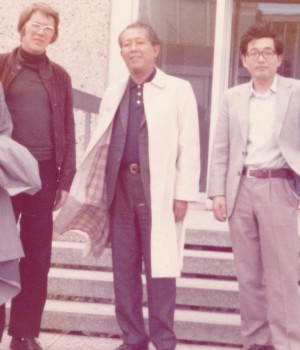Professor Masatoshi Koshiba, who was awarded with Nobel Prize for physics in 2002 for detecting cosmic neutrinos, passed away on 12 November at the age of 94. While he is known for the observation of solar and supernova neutrinos and by Kamiokande, Professor Koshiba will also be remembered as the physicist who started the e+e- collider physics effort in Japan. Throughout the 1960s, ‘70s and ‘80s, he organised groups of younger-generation scientists to form international collaborations to conduct resarch at various e+e- colliders. Professor Koshiba kept up his enthusiasm for e+e- physics and supported the ILC, promoting it as the next particle physics facility the world should build until his last days.
After working as a research associate at the University Chicago, in the early 1960s Prof. Koshiba returned to Tokyo where he continued his research on high-energy particle production in the TeV region using nuclear emulsion techniques, quickly expanding into research programs that use electronic techniques as well. When he attended an international conference in Moscow on cosmic ray physics in the mid-1960s, he made good friends with Prof. Gersh Budker and became strongly interested in e+e- colliding physics. They agreed to collaborate on VEPP-III, which was under construction in Novosibirsk, Soviet Union, in those days. Professor Koshiba formed a group in Tokyo and prepared for the collaboration. After a few years of preparatory studies, however, it turned out the plan would not take off.
Professor Koshiba did not give up the idea of e+e- physics, however, and was helped by his former colleague in Chicago, Professor Erich Lohrmann, who was research director at DESY laboratory in Germany. Professor Lohrman arranged for his old friend to join the DASP experiment at the DORIS collider, led by Professor Bjorn Wiik, who was generous enough to welcome unknown newcomers in his group. Although Professor Koshiba did not join data taking or sign published papers, neverleless he supported the group entirely behind, on behalf of the Tokyo group at DESY, he carried out all the logistics from home, including helping organise the positions of the members, the budget for detector components and travel expenses. The timing of the collaboration was lucky for Koshiba’s group as the new particle J/Psi was found just as the experiment began running. After some days of search for a narrow peak, DASP confirmed the J/Psi signal. This observation became the first outcome of the collaboration.
The e+e- physics was demonstrated to be very productive and became an important research area. Soon, higher-energy colliders were built one after the other. Professor Koshiba’s group, quite experienced by that time, further participated in JADE at the PETRA collider at DESY and OPAL at the LEP collider at CERN, where many young students were trained.
Once Professor Koshiba told me about his life plan that he divided his career as a physicist into three decades. In the first decade he worked very hard on physics to make his way as he had in the U.S. In the second decade he worked to help the younger generation so that they could enjoy physics like he did. And during the third decade he wanted to perform experiments that he would enjoy himself. Professor Koshiba soon realised his wishes for the last decade.
He started another experiment to train students in Japan in looking for proton decay with the water Cherenkov method. The experiment was also be for his own entertainment. I often saw him in the laboratory watching the screen looking for possible signals.
Here again Professor Koshiba was lucky. The water Cherenkov detector, which had been upgraded for solar neutrino detection, observed the neutrinos of the supernova explosion from 160 kilo-light-years away a few weeks before his retirement. When people said it was an extremely lucky event, Professor Koshiba used to reply, “Yes, it was. But you know, the goddess of fortune smiles on those who are well prepared.”
After his third decade of research, which he enjoyed, Professor Koshiba added another decade to his plan to help an even younger generation of scientists.Building on the recognition and the prize fund he received with a Nobel Prize, he established a foundation to promote basic science by encouraging the younger generations. For instance, the foundation provided chances for high school students to experience the pleasure of learning actively from scientists at the frontiers of physics.
Professor Koshiba was a great physicist who thought very deeply with an insight toward the future, strove to realise his ideas and motivated young generations of reserachers.



Recent Comments